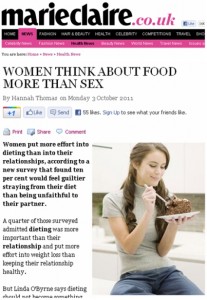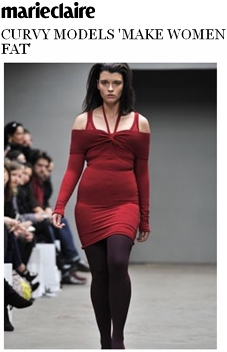What’s fueling your fire in the morning?
Let me guess: SEXCEREAL?!!
This ‘Big Functional Food’ would have slipped by with nary a thought had my friend David Svet not brought it to my attention. But he did and hence, I had to share it with you. After all, it’s Friday and time for some folly.
So, let’s talk about SEXCEREAL, shall we?
This product is not only “the first food product to go viral” (really? What about Life or Tang, which was viral for their time?), but, it is also a ‘gender-based cereal…created with sexual health in mind.’ Wow! It’s downright bodacious and bodylicious!!!
What’s in this amazing, nutritionally-formulated, quality-controlled bowl of desire?
- Maca
- Cocoa nibs
- Sunflower
- Chia seeds
- Almonds
- Flax seeds
- Oat bran
- Ginger
- Oats
Among all of these ingredients, only maca and cocoa have been scientifically studied for their effects on sexual desire. I’ve written previously about maca and the evidence, at least from scientific trials, is pretty scant. Chocolate, on the other hand, has long been considered an aphrodisiac. Yet, when it was studied in women specifically for its effects on scientific desire and pleasure, the data are not so clear; some women have self reported higher levels of desire after eating chocolate but when the data are scrutinized, these results don’t hold. The rest of the ingredients? Honestly, I am lost.
If cereal is your morning bag, you could eat worse; each serving of SEXCEREAL does dose up a nice bit of fiber and omega-3 fatty acids. It’s low in sodium too. But if you are looking for fire, you may want to look elsewhere. And if you are into eating your sex and having it too? Well, there are certainly much better solutions!
p.s. If you want a chuckle, check out the testimonials.… SEXCEREAL – “I love a cereal that goes all the way.” Bob from Saskatchewan
Happy Weekend!
Read More
Java. Café. Kafe. Kaffee. Kava. Coffee. To your health!
 Last week I told you about research findings linking green tea to a lower stroke risk. However, while green tea rocks your socks off when it comes to health, one of my favourite elixirs – coffee — isn’t too far behind in that department. In fact, despite years of negative publicity surrounding coffee, its rightful place in health and diet is being reclaimed. Mind you, too much of a good thing is never a good thing, but there has been renewed interest the multitude of compounds in coffee that extend far beyond the most popular, i.e. caffeine.
Last week I told you about research findings linking green tea to a lower stroke risk. However, while green tea rocks your socks off when it comes to health, one of my favourite elixirs – coffee — isn’t too far behind in that department. In fact, despite years of negative publicity surrounding coffee, its rightful place in health and diet is being reclaimed. Mind you, too much of a good thing is never a good thing, but there has been renewed interest the multitude of compounds in coffee that extend far beyond the most popular, i.e. caffeine.
Globally, 7 million tons of coffee is consumed per year. Wow! That’s a a lot of beans. Moreover, just think of the infinite tons that have been consumed since coffee’s energizing properties were first discovered prior to the start of the 14th Century in Ethiopia. Aside from it stimulative properties, what other treasures lurk each time we reach for a cuppa?
According an extensive review in the online edition of Maturitas, there may be a lot to be gained by consuming this delightful beverage (can you tell how excited coffee makes me?!). Indeed, when the researchers searched and evaluated 22 years of articles, they discovered that the compounds in coffee that are most beneficially linked to health are polyphenols, the most abundant antioxidants in the human diet. Much like chocolate and even green tea, coffee is rich in polyphenols, and the most common are known as phenolic acids, which appears to slow the release of glucose into the bloodstream. This may be an important reason why research has repeatedly shown that coffee has a protective effect against diabetes, although one needs to have a moderate to high intake (4-6 cups a day) to achieve the best protection.
Drinking coffee may also help defend against liver damage, regardless if the culprit is a virus, drugs, alcohol or abnormal, malignant cells, although experts can’t yet explain why. Still, in studies, this protection was seen in both healthy and at-risk populations in numerous studies.
Another potentially important benefit of coffee is a reduced risk of Parkinson’s Disease; significant reviews have suggested that this reduction may be as high as a third. An important part of this story is that in postmenopausal women, HRT may shift this benefit to the negative side, and actually convert the protective role of caffeine into a risk factor for Parkinson’s (yet another reason to reconsider taking hormones).
So, what about heart disease? The buzz has long been that drinking coffee can increase blood pressure, worsen irregular heart rhythms and raise cholesterol levels. The review authors say that better and more ample clinical data, coupled with a greater understanding of the multiple components of coffee other than caffeine, have changed the paradigm. Importantly, the very compounds mentioned earlier — phenolic acids – and the pattern they form depending on the variety of coffee, roasting and processing, may help neutralize or reverse the negative. The most important hero in this story is a derivative of a common type of phenolic acid: chlorogenic acid.
Chlorgenic acid improves the function of cells that line the blood vessels and may work to attenuate increases in blood pressure. In women, coffee intake and perhaps the activity of chlorogenic acid may lower coronary heart disease. Moreover, detailed evaluation of available evidence fails to demonstrate a higher risk for abnormal heart rate or sudden cardiac death. And, while the verdict is still out, the researchers say that coffee may even exert a protective effect against cancer, possibly asa result of its antioxidant/antiinflammatory effect.
Before you up your daily caffeine intake, keep in mind that there is still much to be discovered about coffee. Many of these studies were observational studies, meaning that there was no attempt to control the outcomes with treatment. And response to certain compounds within coffee may be individually-driven. Still, in moderation, coffee may be less harmful (and more beneficial) than we have been led to believe.
Coffee equals the black, irreplaceable elixir in any language. To your health? Indeed!
Read More
Spilling the beans on coffee and caffeine
 Coffee, alcohol, chocolate. Can’t live with them. Can’t live without them, right? Well, if you are like me, you may be intrigued by evolving research into these three substances in terms of health. In fact, back in May, I wrote about published research examining the effects of coffee on longevity. You can find that piece here.
Coffee, alcohol, chocolate. Can’t live with them. Can’t live without them, right? Well, if you are like me, you may be intrigued by evolving research into these three substances in terms of health. In fact, back in May, I wrote about published research examining the effects of coffee on longevity. You can find that piece here.
Meanwhile, back on the research front, I ran across an editorial in the online edition of Maturitas that provides a deeper dive into coffee and what we, as consumers, are actually drinking every time we purchase a cup in a coffee shop. And the data may astonish you because while the serving sizes of espresso are within similar ranges, the caffeine content varies as much as two to almost six-fold. And let’s face it; most of us drink coffee for the taste. And for the caffeine effects.
However, as the authors point out, when it comes to commercially purchased coffee, it’s almost impossible to determine how much caffeine one is actually ingesting. This makes it difficult to stay within guidelines outlined by the International Food Council that suggest that moderate intake of caffeine equates to roughly three 8 oz cups a day, or 300 mg per day. (FYI: on average, it takes 5 hours for most adults to metabolize and excrete about half the caffeine consumed — in scientific circles, this is called “half-life”). And while this may seem unimportant to most, too much caffeine not only promotes insomnia or feeling jittery, but in amounts over the moderate intake level, may be downright dangerous for pregnant women (whose fetus can’t metabolize the purine akaloid in coffee). On the flip side? Regular coffee intake can help control gycemic levels (so long as you don’t add sugar), reduce the risk of depression and reduce cognitive decline, especially in women.
So, what do you need to know before you buy that next cuppa?
- Different coffee shops used differing amounts of coffee to prepare their coffee drinks.
- Barista methods vary from shop to shop and factors like water temperature, steam, time brewed, etc, all play a role.
- If you are a latte or cappuccino lover, your espresso is diluted but to what extent is a mystery.
- Beans are harvested, roasted and ground differently from one cup to the next.
The authors say to have no fear but to insist on “good quality, 100% arrabica beans,” and to start paying attention to the process. I think that this advice is a bit far fetched because short of being one of ‘those’ customers, I don’t see how one can control or demand. Starbucks is Starbucks, right? BTW, while the analysis was conducted in Scotland, Starbucks espresson had the lowest level of caffeine per serving — only 51 mg, which begs the question, what are you paying for when you drop $5 on the double espresso?
So, “what’s in your cup?” It’s fairly intuitive that a few visits to the same coffee shop will yield a lot of non-scientific answers; if two espressos cause a whole lotta jitters, have one the next time. That aside, I suggest a home brew to take all questions off the table.
Read More
All the rage…menopausal women
I had hoped to go for the chocolate trifecta this week. But this video reminded me that I need to devote more time to laughing and less to the clinical side of this transition. While this is definitely a repost, it’s too good to pass up .
Happy Friday and Happy Weekend. Enjoy!
Read More
Wednesday Bubble: Should Fatties Get a Room…and Other ‘Fine’ Assaults on Women… Guest Post by Dr. Brian Hughes
My friend Dr. Brian Hughes is at it again. “At what,” you ask? At identifying media assaults on women, on aging and on identities. You may recall that I ran Brian’s piece on ageism back in July of this year. And I am honored to run another post. Once again, I hope that you’ll show Brian some love and spread the word, not only about the post but also his work on The Science Bit Blog. Many thanks Brian!
I don’t know much about Marie Claire, but it appears to be some sort of magazine/website for people who hate women. At least, that’s the conclusion I drew from reading this story in their UK edition’s Health News section: “Women Think About Food More Than Sex“. In genre terms, this is something of a high concept piece, one of those articles that sums up everything it has to offer within the phrasing of its title alone (a bit like “Snakes on a Plane“).
So what did they find? Firstly, a full 25% of women ”admitted” that dieting was more important to them than their intimate relationships. In fact, get this:
…ten per cent would feel guiltier straying from their diet than being unfaithful to their partner.
That’s right. Marital (or relationship) infidelity — the stuff of epic romantic drama at least since the mythology of the ancient Greeks — is actually not that significant after all. What matters more is diet adherence. So, while Hester Prynne appeared somewhat perturbed throughout The Scarlet Letter, at least all she had to deal with was the stigma of her sexual indiscretion. Imagine if the townsfolk found out about that extra chocolate biscuit she used to scoff during coffee breaks…
Here are some more findings:
The most common reason for women in the UK to start a diet is to get the perfect beach body–while one in seven say cruel taunts are the reason they reign [sic] in their eating.
So women become self-conscious about their bodies due to beach paranoia andtaunting, eh? Well I guess that has nothing at all to do with articles appearing in magazines. Magazines like Marie Claire, for example…
How about these delightful pieces: “Are Leggings Making You Fat?“; “Could Your Fridge Be Making You Fat?“; “Curvy Models ‘Make Women Fat’“; “Diets That Make You Fat“; “Healthy Foods That Make You Fat“; “Is Your Air Conditioner Making You Fat?“; “Can A Common Virus Really Make You Fat?“; “3 Surprising Things That Make You Fat” (stilettos, your partner’s education, and boredom, apparently); “3 Fats That Make You Skinny” (ooh-er, now I’m confused); “10 Best Celebrity Beach Bodies“; ”From Flab To Fab: Your Holiday Survival Guide“; and “Get A Beach Body Fast“.
Uh huh. No grounds for paranoia or for beach-body neurosis there at all.
And as for cruel taunts, how about this memorable Marie Claire column called ”Should ‘Fatties’ Get A Room?“ Here’s an excerpt:
So anyway yes, I think I’d be grossed out if I had to watch two characters with rolls and rolls of fat kissing each other…because I’d be grossed out if I had to watch them doing anything. To be brutally honest, even in real life, I find it aesthetically displeasing to watch a very, very fat person simply walk across a room…
I think I understand why “one in seven (UK) women” modify their eating due to “cruel taunts“. They are obviously Marie Claire readers.
Still, while all that looks pretty terrible and offensive, at least Marie Claire quote a nutritionist to advise readers that “Dieting should never become an obsession“. So that’s alright then. Hands washed.
As it happens, “women think about food more than sex” is a well phrased, nicely falsifiable hypothesis. Either it is true or it is not. All that we need is data from a sample of women that is both large and statistically representative of the general population, regarding (a) the extent to which they think about food and (b) the extent to which they think about sex. Then we can do a simple statistical test tocompare these two values in order to determine which subject, on average, is thought about the most.
But of course, that’s not what we get here. Instead we have a pretty standard population-based survey study, with minimalist description of methodological details. Marie Claire report the findings as “Health News“, presenting statistical factoids that imply a basis in a comprehensive dataset but avoiding anything as troublesome as even a sample size.
In fact, according to the UK Press Association, the study examined responses from over 1,200 women, which sounds comprehensive enough. However, we are not told what questions were asked or what other findings the researchers discovered. This is because the study is not actually a piece of formal science. Rather, it’s a bog standard market research survey conducted by a private company who have a commercially vested interest in reporting particular results.
The survey is brought to us by Atkins, the people who make a profit every time a woman buys one of their dieting products. They seem to churn out lots of this type of research (see here, here, and here), all of which goes directly to newswires and yields findings that encourage women to turn dieting into an obsession. And thatnutritionist that Marie Claire get to warn women not to turn dieting into an obsession? Yeah, well she works for Atkins. In fact, she’s their “Chief Nutritionist“.
 Guess which one of these corporate value statements is my favourite
Guess which one of these corporate value statements is my favouriteWe’ve been here before. Pseudoscience in the service of corporate greed is depressing enough on its own. But it is truly amazing how women’s magazines and media outlets become complicit in this baloney. Instead of providing a service that is of actual benefit to women, these magazines end up assisting a corporate marketing strategy designed to maximize profits by generating and exploiting reader confusion.
Hey, for all I know (and I don’t), women might well think more about food than about sex. But let’s just remember this. Women’s magazines think more about their profitable relationships with corporate advertisers than about the edification — or mental health — of their readers.
Yeah! Go women!
About the author…
Dr Brian Hughes is a lecturer in Psychology at the National University of Ireland, Galway and author of Conceptual and Historical Issues in Psychology (Prentice Hall, 2011). When he is not writing or lecturing, you can find him lending his views on Twitter.
Read More








